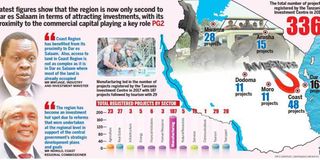Why Coast Region is a magnet for investments

What you need to know:
- Strategic interventions, among other investment attraction tactics, are the main driver leading to the region fast becoming an investment hot spot.
Dar es Salaam. Coast Region is increasingly becoming a preferred investment destination for prospective local and international investors.
Strategic interventions, among other investment attraction tactics, are the main driver leading to the region fast becoming an investment hot spot.
Indeed, the latest figures show that the region is now only second to Dar es Salaam in terms of attracting investments.
A report by the National Bureau of Statistics (NBS) shows that Coast Region attracted investments in a total of 48 new projects in 2017 alone. By comparison, Dar es Salaam Region attracted investments in 163 projects in the same year, and which were duly registered by the Tanzania Investment Centre (TIC)
Mwanza Region, which is the second largest regional contributor to gross domestic product after Dar es Salaam, came third, with only 28 projects registered by TIC in 2017.
Despite being Tanzania’s tourism hub, Arusha could only manage 15 project investments registered by TIC in the same year.
Other regions which were able to attract investors in 2017 were Morogoro and Dodoma, each of which attracted 11 projects. The country’s other 20 administrative regions registered less than ten project investments with TIC last year.
Industry, Trade and Investment minister Charles Mwijage told The Citizen that Coast Region benefited from its proximity to Dar es Salaam, which is home to Tanzania’s biggest and busiest port.
Also, access to land in Coast Region is not as complex as it is in Dar es Salaam where most of the land is already occupied in one way or another.
“It is easy for one to access (say) a ten-acre piece of land in Coast Region than it is in Dar es Salaam,” he said.
According to Coast Regional Commissioner Evarist Ndikilo, the region has become an investment hot spot due to reforms that were undertaken at the regional level in support of the central government’s strategic development plans and goals.
“We have held several meetings at which we deliberated on playing a role that would ensure Tanzania becomes a semi-industrialised middle-income country by 2025,” Mr Ndikilo said, adding that the meetings involved district commissioners, district Executive directors and village chairpersons in the region.
“It is at such meetings that I directed the relevant authorities in the region to set aside suitable land for industrial investment, avoiding bureaucratic procedures in land acquisition,” he said.
The regional authorities also asked the relevant authorities to build roads to facilitate the transportation of industrial products to markets.
Water, electricity and environmental protection authorities are also key players in Coast Region’s developmental agenda.
“I also talked to the Immigration and Labour people, convincing them to issue resident and work permits promptly. I held meetings with those who issue building permits to issue clearances swiftly. We also advertise our investment opportunities on our website,” Mr Ndikilo explained.
The region’s annual contribution to GDP has grown from about 1.8 per cent a few years ago to about three to four per cent presently.




